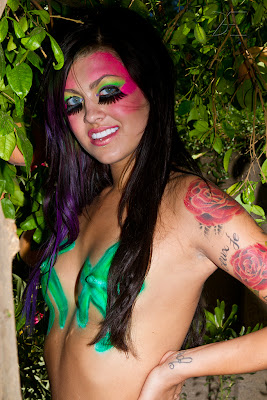 |
| Cat Moone |
In continuation from the last post, the question of the worth of group photoshoot events should be addressed. Do the benefits outweigh the negatives in the areas of skill building, networking, and efficient use of time?
 |
| Cat Moone |
The first area—skill building—is a complex one to address because how photographers and models learn can vary. I breakdown photographers into 3 basic groupings: theoretical actualizers, spur experimentalists, and task-dependants.
Theoretical actualizers set up—via diagram or mental images—the shoot concepts, lighting, wardrobe, and potentially even the poses they desire.
They then take this vision and attempt to make it reality in the actual photoshoot. Actualizers find pleasure in taking the concept to execution and may even enjoy the post-production work as much or more than the setup process. Spur experimentalists may have an initial shoot concept but work primarily from the idea that the best product comes from a collaborative flow of ideas as the shoot is going rather than a rigid plan of shooting: this creative process runs throughout all aspects including lighting, wardrobe, poses, etc. Task-dependants keep a relatively stable process that only varies in the dimensions required of the shoot. While they may not be the most intuitively creative photographers, they do produce a product of consistent quality.
 |
| Kimm Davies |
The issue then becomes which type benefits more from a group photoshoot endeavor and how does this benefit play out? Novice theoretical actualizers can benefit from a group photoshoot, but need to receive information about the shoot, lighting arrangement, wardrobe, etc. for them to utilize the shoot experience in planning the next solo photoshoot. In other words, the shoot done today helps improve the shoot done tomorrow. The multiple model nature of most group photoshoots allows the novice spur experimentalist an opportunity to try setups, lighting, poses that haven’t been done before.
However, the novice task-dependant is tends to benefit less in skill building than the other types in group photoshoots.
 |
| Kimm Davies |
If the photographer doesn’t have the resources to duplicate the shoot variables (environment, lighting, wardrobe, model, etc.), the novice task-dependant doesn’t really understand how to innovate beyond the groupshoot. Thus, the type of photographer who benefits most from a group photoshoot is probably the spur expirementalist.
 |
| Natalie Angela |
When it comes to networking—the utilization of exposure, building of social capital, and the expansion of brand/product recognition—all three types of photographers can benefit from a group photoshoot. This is because the benefit has little to do with the type of photographer and more to do with the personality & likeability of the shoot participants, and the socializing opportunities available at the shoot. It is the same principle behind the success of meet & greet events.
The last question about time efficiency is multilayered because ultimately efficiency depends not just upon the photographer but also the type of shoot and how many other individuals are involved in the shoot. Assuming all the non-photographer variables are equal, a novice theoretical actualizer can benefits if he/she has foreknowledge of the photoshoot variables. Thus the actualizer has the potential to cram many more high-quality photographs in than the average photographer.
 |
| Kimm Davies |
The spur experimentalist is also capable of obtaining more high-quality photographs than the average photographer. However, the spur experimentalist is also capable of ending up with more junk as well. Not everything tried will succeed, but when success is obtained it will yield wonderful product. So unlike the actualizer whose product is directly related to how much forthought is put into the group photoshoot, the experimentalist will—on average—benefit from the shoot, but there is no guarantee. The task-dependant is least likely to benefit from a group photoshoot, because the benefit garnered comes completely from the quality and organization of photoshoot organizer. A free-for-all shoot is the least efficient, a small, meticulously detailed shoot is more efficient.
 |
| Natalie Angela |
Today’s images are from a themed bodypaint shoot. The goal was to have the models painted in water-resistant paints in designs reminiscent to mermaids. Unfortunately the bodypainter really dropped the ball on this shoot, showing up late and neglecting to bring the proper type of airbrush paints. Consequently, once the models got wet paints wet, the paint flecked off rapidly and the designs became unusable within about 4 minutes. Overall the models were a pleasure to work with.
 |
| Natalie Angela |
The father of one of the models had been diagnosed with a myocardial infarction the prior evening and was hospitalized. It was clearly weighing on the model (you can see in the images the progression of unhappiness) and she left the shoot early to go be with her family. Since that day, I don’t think she has modeled again, I’ve been unable to ever contact her, and she hasn’t logged onto to her MM account. I always wonder what happens to models that drop of the face of the modeling earth. Another model from that day has ceased to model and discontinued her MM account. I sometimes wonder if it is life, discontent, or familial/social pressures that lead once enthusiastic models to completely cease modeling. For women in their late teens and early twenties, I know from discussion that it is hard for them to forsee all the future consequences from modeling. But I’ve also witnessed individuals in their late twenties and early thirties summarily drop out so I’m unsure if unforeseen consequences is the only reason.
 |
| Cat Moone |
 |
| Natalie Angela |










No comments:
Post a Comment